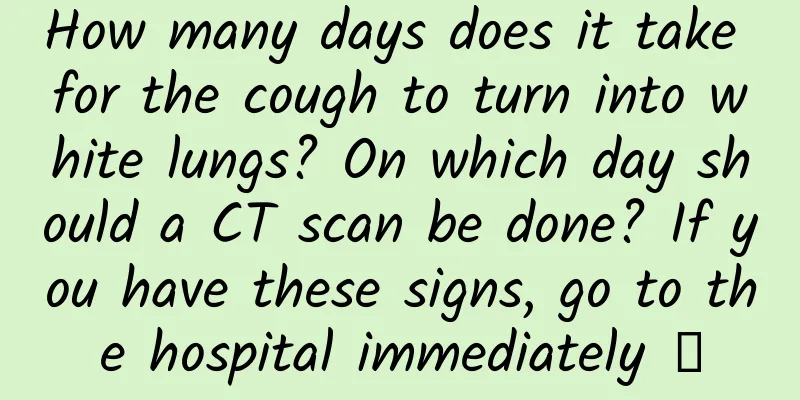How many days does it take for the cough to turn into white lungs? On which day should a CT scan be done? If you have these signs, go to the hospital immediately →

|
In just one week, the 8-year-old girl developed a cough and then developed white lungs . A 5-year-old boy in Changsha was infected with influenza A and suddenly suffered from leg pain and was unable to walk. He was diagnosed with acute myositis . An 8-year-old child in Guangdong was infected with influenza B and developed acute necrotizing encephalopathy and was admitted to the ICU. It’s okay to read these news normally, but when children really have a headache or fever, all the scary cases they have read will appear in front of them and become real anxiety: Why hasn’t the child’s fever gone down? Could it be encephalitis that’s damaging his brain? I have been coughing for several days. Could it be pneumonia? I was so nervous. I had to do something, right? I had to give him anti-inflammatory drugs and antibiotics right away, and cough suppressants to stop him from coughing. Or I could just take him to the hospital for an IV, and get a CT scan, or do some nebulization. Once a full set of physical examinations are done and all treatments are arranged, I feel comforted, but is this really the right thing to do? On the one hand, I learned from popular science that self-limiting diseases do not require much intervention. On the other hand, I am anxious and worried, afraid that treatment will be delayed, and a minor illness will turn into a big problem, which will affect my child. How to break this dilemma? What to do when your child is sick depends on the benefit/risk ratio First of all, it is undeniable that the scary cases mentioned at the beginning are real. Respiratory infections can lead to severe illness/complications or even death. Colds, influenza, COVID-19, Mycoplasma pneumoniae, and syncytial virus are all self-limiting diseases, but the disease burden they cause worldwide cannot be underestimated. However, the existence of influenza does not mean that we should always worry about it . Influenza can cause severe illness and death, but this is relatively rare, especially in previously healthy people without underlying diseases. There is no need to panic every year when the flu season comes, and arrange a full set of examinations and various treatments as soon as you are infected. We live in the Internet age, with the development of social media, and this type of eye-catching news such as "So-and-so's lungs turned completely white after getting the flu!" is extremely topical, and with the help of traffic and high exposure, it gives people the illusion that "it is easy to develop white lungs after getting the flu." Social media not only spreads information, but also anxiety. Do you really want to ask whether the virus is becoming more and more dangerous, people are becoming more and more vulnerable, more likely to get sick, and more likely to be seriously ill? The answer is obviously no. There is no need for low-probability events to evolve into mass anxiety. What if? We all understand the principle of low probability events, but what if the child is that low probability? When thinking of "what if", even the most stable parents can't remain calm. If the child is sick, they must do some examinations and treatment, right? Otherwise, they will feel uneasy. This leads to the second point, the benefit/risk ratio. In plain words, it is about weighing the pros and cons. If you are worried that your child's cough may develop into pneumonia, and you give your child cough suppressants and anti-inflammatory drugs on your own, will the benefits (can it prevent pneumonia, shorten the course of the disease) be greater, or will the risks (drug side effects, antibiotic resistance) be greater? To put it more bluntly, will taking a sick child for various tests and treatments really help the child recover quickly, or will it be a hassle for the child, yourself, and your wallet? Here are a few common examples: 1 My child has been coughing for several days and hasn't recovered. I'm worried that it might be pneumonia, so I took him to the hospital for a chest X-ray/CT scan. Chest X-ray/CT should be done only when necessary. “Necessary” does not mean the “just in case” that parents worry about, but when there are relevant indications. According to the UpToDate clinical advisory, a chest X-ray may be needed if your child: 1. Severe pneumonia: body temperature > 38.5°C, accompanied by symptoms such as increased respiratory rate (more than 70 times/minute for infants and more than 50 times/minute for older children), moderate/severe three-recess sign, severe dyspnea, flared nostrils, cyanosis, poor mental state, etc. 2. The doctor highly suspects that the child has pneumonia, but the combined clinical manifestations do not allow for a diagnosis of pneumonia. 3. Complications need to be evaluated, especially in children with pneumonia who do not improve after treatment. … Some tests suspect pneumonia, but children with mild symptoms, stable vital signs, and no need for hospitalization do not need to undergo routine chest X-rays to confirm the diagnosis, let alone CT scans with higher radiation doses. Whether to take a chest X-ray or CT scan is not based on whether the child has coughed for a few days but has not recovered , but should be considered comprehensively based on clinical manifestations, disease course, previous health conditions, and other factors. If the doctor's assessment does not meet the indications, but the parents request the filming, the doctor will arrange it in most cases. However, it does not actually affect the treatment plan, and the child will still be treated as usual. In addition to bothering children and wasting money, considering the radiation risks of imaging examinations, it is recommended that parents do not take their children for chest X-rays/CT scans at every turn. Although a single examination is a low-dose exposure and will not harm health, if this is done as a routine item, the risk is hard to say. Copyright images in the gallery. Reprinting and using them may lead to copyright disputes. 2 The child has a fever. Take him to the hospital immediately for an IV drip so he can get better soon. Intravenous infusion is a major area of over-medicalization in China. Just look at the magical operations that have occurred before. Can intravenous infusion help children get better faster? Not necessarily . The contents of infusion are nothing more than antibiotics, antivirals, glucose, saline, and Chinese patent medicine injections. In most cases, they are mixed together. The main goal is to cast a wide net and the efficacy depends on luck. If the infusion is antibiotics, most upper respiratory tract infections are caused by viruses, and antibiotics are ineffective and have side effects such as drug resistance; if the infusion is antiviral drugs, why not choose oral administration; if the infusion is glucose saline, is the child's symptoms so severe that he refuses to eat or drink and is dehydrated? If the infusion is Chinese patent medicine injection, then you know the reason for rejection. Simply put, intravenous infusion is considered only when the child is unable to take medicine, vomits after taking it, has severe symptoms, is listless, or is dehydrated and exhausted. And considering the potential risks of intravenous infusion, it is usually recommended to "take it orally instead of intramuscularly, and don't infuse it instead of intramuscularly". 3 The child has a cough. What if the cough turns into pneumonia? Take some cough medicine immediately. Pneumonia is not coughed out, and there is no causal relationship between the two. Coughing is a normal phenomenon of upper respiratory tract infection, and it is usually the last symptom to disappear. Sometimes children continue to cough after they have recovered from the illness. In most cases, it is a normal persistent cough. Seeing a child coughing badly, people conclude that the child has pneumonia, and give the child cough medicine to prevent it from developing into pneumonia. This is a huge misunderstanding. Cough medicine has no effect in preventing pneumonia. Some syrup-type cough medicines mainly use sweetness to moisten the throat and relieve discomfort. If you want to achieve this effect, you can just use a lollipop instead. Why bother taking medicine? Some cough medicines contain codeine and dextromethorphan, which are indeed effective but also have risks. Codeine is an opioid drug that carries a risk of addiction and may cause respiratory depression and, in severe cases, death. Dextromethorphan is a centrally acting antitussive drug and its abuse may cause psychiatric symptoms in children. Its use with antiallergic drugs and antipyretics may cause complex poisoning symptoms. 4 If your child has a fever, buy a home testing kit to find out what the disease is . This rapid test kit, which can screen for 12 types of respiratory viruses and bacteria, has been very popular recently. It is comprehensive and cheap, and you don’t have to go to the hospital and squeeze in with crowds. It looks good and convenient, but it is not actually recommended. On the one hand, this test may be inaccurate, not in terms of technical inaccuracy, but the reference result may be biased. For example, if a positive result for pneumococcus is found, it does not mean that the child is infected with pneumococcus. It is also possible that the bacteria have colonized the respiratory tract. It is obviously unreasonable to prescribe antibiotics for treatment based on a positive result. As for Mycoplasma pneumoniae, the UpToDate clinical consultant mentioned that the results need to be interpreted with caution , because a positive Mycoplasma pneumoniae may also be an asymptomatic carrier or mixed infection. Testing positive for a certain pathogen does not mean that the current symptoms are caused by this pathogen . On the other hand, pathogen testing does not affect the treatment plan in most cases. Generally speaking, it is not necessary to distinguish the pathogen of respiratory tract infection because the means of supportive symptomatic treatment are universal. Of course, if there are elderly people with underlying diseases or other people at risk of severe illness in your family, you can buy a rapid test to make a preliminary diagnosis, but after all, there is a risk of severe illness, and the final treatment plan still requires returning to the hospital to consult a doctor, so it seems a bit useless. The above are just some examples due to space limitations. Similarly, there are also nebulization, oral antibiotics, lung lavage, etc., which are all treatment options that parents may try in a panic. When the child does not show the corresponding indications, taking these measures to "prevent" the disease from becoming more serious does not have much practical significance other than seeking peace of mind, and most of the time the risks outweigh the benefits. Don't overreact, doesn't mean do nothing Respiratory infections are minor illnesses that don't require medication or care and will go away after a few days. This is going from one extreme to another. If you have an underlying disease, whether it is a self-limiting disease or not, you must be more careful. If the course of the disease is too long, the condition recurs without improvement, or you find that you have abnormal breathing, you should seek medical attention in time. As for previously healthy people, in addition to the well-known symptomatic supportive care methods, they should not be too indifferent to self-limiting diseases. The most important thing is to observe their mental state and monitor symptoms , and seek medical attention in time if any abnormalities are found. Shortness of breath is the most prominent manifestation of gas exchange disorder and tissue hypoxia in children. WHO defines shortness of breath as the only criterion for pneumonia. Shortness of breath is defined as: Infants aged ≤2 months with respiratory rate >60 times/minute; · Respiratory rate of infants aged 2 to 12 months > 50 times/minute; · Children aged 1 to 5 years with a respiratory rate > 40 times/minute; Children aged ≥5 years with a respiratory rate greater than 20 breaths/minute. Parents should carefully count their children's breathing rate. If they find that their child's breathing rate is significantly higher than usual, or breathing is more difficult than usual, it is recommended to arrange for the child to see a doctor as soon as possible. In addition, parents are also advised to pay attention to whether their children have other typical symptoms of pneumonia, such as skin indentation between and around the ribs and sternum, chest pain (especially when coughing or taking deep breaths), wheezing, blue lips and fingernails (caused by low blood oxygen levels), etc. If so, please take your child to the doctor immediately. in addition: If chest pain, palpitations, rapid heartbeat, etc. occur during non-coughing periods, especially if they occur repeatedly, you should take it seriously as it may indicate myocarditis and you should seek medical attention promptly. A barking cough, wheezing, and inspiratory three-depression sign may indicate acute laryngitis and require prompt medical attention. Persistent headache, abnormally high fever, extreme drowsiness, poor mental state, inability to be awakened or unresponsive when called may indicate encephalitis and requires prompt medical attention. The child is in a bad mental state: listless, confused, irritable, for example, crying weakly, unable to cry, drowsy and unable to wake up, no response to conversation or laughter, refusing to drink or eat, etc. The medication is not effective, the fever recurs repeatedly, and the high fever persists (over 40°C); the fever persists for more than 24 hours (<2 years old); the fever persists for more than 72 hours (>2 years old); other symptoms appear, such as frequent vomiting and diarrhea, severe headache, ear pain, etc. If a baby under 3 months old has fever symptoms, please go to the doctor immediately and do not use antipyretics on your own. Children under 5 years old, especially those under 2 years old , are at high risk of influenza complications. Parents should handle the situation calmly while observing their children's condition . If there is any abnormality or uncertainty, please go to the doctor in time. Once again, I would like to remind you that it is rare for an upper respiratory tract infection to develop into a serious disease. Parents can learn more about it and have more peace of mind, but there is no need to be anxious, worried or overreact. Life is hard enough, so don't waste your time working on it. References [1]UTD: Clinical features, diagnosis, and complications of acute respiratory distress syndrome in adults Planning and production Source: Dr. Ou Xi Editor: Zhong Yanping |
Recommend
After the release of iOS 10, what new ways of ASO optimization are there?
APP optimization is divided into two aspects. The...
Asking for water from the sea is no longer a dream? my country can desalinate more than 1.6 million tons of seawater every day!
Author: Duan Yuechu Desalination technology is an...
Internet mobile phones enter the knockout round, Xiaomi and others face deep distribution challenges
"What is the most powerful weapon I have? In...
Can eating garlic regularly lower blood pressure? Doctor: If you want to stabilize your blood pressure, you really should eat less of these 3 types of food
Reviewer of this article: Chen Haixu, Deputy Dire...
Thyroid cancer is becoming more and more common. What should you eat after surgery?
The thyroid gland is the largest endocrine organ ...
Why are mobile phones so expensive nowadays?
When we read information about mobile phones, we ...
How to attract traffic on Weibo? Precise traffic generation techniques on Weibo!
In this era, many people are scrambling to gather...
Public account operation: 6 principles for selling products on public accounts!
Since the rise of public accounts, many brands an...
APP promotion: Only by mastering those data and channels can you get 1 million users!
Whether it is a large company or a small business...
By the end of 2023, we will have met 4 new “friends” outside the Milky Way!
Author: Fang Yangxuan, Zhao Jingyuan Review | Zou...
[Smart Farmers] The Wandering Earth from an Agricultural Perspective: This tiny transparent creature may become the last source of animal protein for humans
Editor’s Note: The recent hit of "The Wander...
The creator of Android announced his resignation and is willing to provide opportunities for more companies
Beijing time, October 31 morning news, Google ann...
Why is there no traffic for live streaming sales on Douyin? How to increase traffic with Douyin live streaming
For those who are currently doing live streaming ...
9 examples of obtaining seed users
I often joke with my friends: Young people, don’t...
Hot search! I get stomachache when I get angry, what's going on?
Expert of this article: Wang Xiaohuan, Doctor of ...

![[China Association for Science and Technology Agricultural Technology Center "Smart Mom"] Late autumn is approaching, do you really drink water? Here is a "nanny-level" guide to hydration →](/upload/images/67f1e35f9733c.webp)







